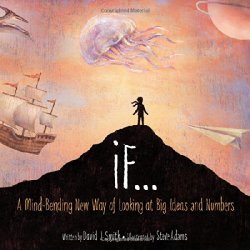A Mind-Bending New Way of Looking at Big Ideas and Numbers
by David J. Smith
illustrated by Steve Adams
Kids Can Press, 2014. 40 pages.
The author of the brilliant If America Were a Village is at it again, using scale to give children a feeling for enormous numbers. Here’s what he says on the first page:
How big is Earth or the Solar System or the Milky Way galaxy? How old is our planet and when did the first animals and people appear on it? Some things are so huge or so old that it’s hard to wrap your mind around them. But what if we took these big, hard-to-imagine objects and events and compared them to things we can see, feel and touch? Instantly, we’d see our world in a whole new way. That’s what this book is about – it scales down, or shrinks, huge events, spaces and times to something we can understand. If you’ve had a doll or a model airplane, you know what scaling down means. A scale model is a small version of a large thing. Every part is reduced equally, so that you don’t end up with a doll with enormous feet or a model plane with giant wings. And when we scale down some really huge things – such as the Solar System or all of human history – some of the results are quite surprising, as you are about to see…
The book goes on to look at such scenarios as:
If the Milky Way galaxy were shrunk to the size of a dinner plate…
If the planets in the Solar System were shrunk to the size of balls and Earth were the size of a baseball…
If the history of the last 3000 years were condensed into one month…
If the inventions of the last 1000 years were laid out along this ruler…
If all the water on earth were represented by 100 glasses…
If all the wealth in the world were represented by a pile of 100 coins…
If average life expectancy (the number of years people live) were represented by footprints in the sand…
If today’s world population of over 7 billion were represented by a village of 100 people…
If your whole life could be shown as a jumbo pizza, divided into 12 slices…
With each scenario, graphics on a double-page spread show how the hypothetical object would be divided up, with some surprising results.
In the your-life-as-a-pizza example, 4 of the 12 slices would be work and school and 4 of the 12 slices would represent sleeping. In the wealth example, we see one person standing on top of a pile of 40 coins, 9 people on top of the next 45 coins, on down to 50 people standing on the one lone last coin. With footprints in the sand, we see the footprints from some continents don’t go nearly as far as those from others.
The population example may be the most interesting, because the author goes back in time. If today’s population were represented by a village of 100 people, the village in 1900 would only have 32 people, in 1500 only 8 people, and in 1000 BCE, there would have only been 1 person.
You get the idea: These ideas and images give you a grasp of the large proportions between these things and a handle for understanding enormous numbers.
Find this review on Sonderbooks at: www.sonderbooks.com/Childrens_Nonfiction/if.html
Disclosure: I am an Amazon Affiliate, and will earn a small percentage if you order a book on Amazon after clicking through from my site.
Source: This review is based on a library book from Fairfax County Public Library.
Disclaimer: I am a professional librarian, but I maintain my website and blogs on my own time. The views expressed are solely my own, and in no way represent the official views of my employer or of any committee or group of which I am part.
What did you think of this book?
